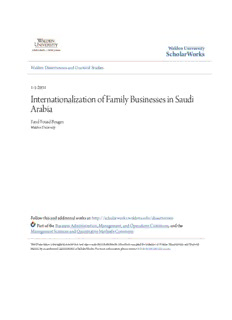
Internationalization of Family Businesses in Saudi Arabia PDF
Preview Internationalization of Family Businesses in Saudi Arabia
Walden University ScholarWorks Walden Dissertations and Doctoral Studies Walden Dissertations and Doctoral Studies Collection 1-1-2011 Internationalization of Family Businesses in Saudi Arabia Farid Fouad Bouges Walden University Follow this and additional works at:https://scholarworks.waldenu.edu/dissertations Part of theBusiness Administration, Management, and Operations Commons, and the Management Sciences and Quantitative Methods Commons This Dissertation is brought to you for free and open access by the Walden Dissertations and Doctoral Studies Collection at ScholarWorks. It has been accepted for inclusion in Walden Dissertations and Doctoral Studies by an authorized administrator of ScholarWorks. For more information, please [email protected]. Walden University College of Management and Technology This is to certify that the doctoral study by Farid Bouges has been found to be complete and satisfactory in all respects, and that any and all revisions required by the review committee have been made. Review Committee Dr. Gene Fusch, Committee Chairperson, Doctor of Business Administration Faculty Dr. Freda Turner, Committee Member, Doctor of Business Administration Faculty Dr. Yvette Ghormley, University Reviewer, Doctor of Business Administration Faculty Chief Academic Officer Eric Riedel, Ph.D. Walden University 2013 Abstract Internationalization of Family Businesses in Saudi Arabia by Farid Fouad Bouges PMP, Project Management Institute, 2008 MS, Electrical Engineering, King Abdulaziz University, 2005 Doctoral Study Submitted in Partial Fulfillment of the Requirements for the Degree of Doctor of Business Administration Walden University November 2013 Abstract Family businesses represent a key economical asset in the global economy. Leaders of family businesses have implemented internationalization as a key strategy to enhance sustainability and increase profitability in a hypercompetitive global marketplace. Guided by the Uppsala model, the purpose of this case study was to explore how Saudi family business leaders have planned and implemented internationalization. Three leaders from different international Saudi family businesses participated in semistructured interviews. The participants described their experience in achieving successful internationalization for their family businesses. After analyzing the interview data and validating through member checking, 3 main themes emerged: (a) the characteristics of the family business to compete internationally, (b) the characteristics of a suitable international market for family businesses to internationalize, and (c) the characteristics of a successful internationalization opportunity for a Saudi family business. In order to internationalize, Saudi family business leaders identified having a proper strategy, financial capability, qualified resources, well-structured policies, and globally-standardized products or services. Family business leaders should target the international market that is stable, that is secure with regulations, and that is welcoming to foreign investments. Each internationalization opportunity should have close psychic distance, available relationships in the international market, targeted family business motives, demonstrated existing market demand with the ability to satisfy, and proper timing. The findings may promote social change in Saudi family businesses by identifying essential characteristics to maintain the companies’ existence and offer a roadmap to compete internationally. Internationalization of Family Businesses in Saudi Arabia by Farid Fouad Bouges PMP, Project Management Institute, 2008 MS, Electrical Engineering, King Abdulaziz University, 2005 Doctoral Study Submitted in Partial Fulfillment of the Requirements for the Degree of Doctor of Business Administration Walden University November 2013 UMI Number: 3603933 All rights reserved INFORMATION TO ALL USERS The quality of this reproduction is dependent upon the quality of the copy submitted. In the unlikely event that the author did not send a complete manuscript and there are missing pages, these will be noted. Also, if material had to be removed, a note will indicate the deletion. UMI 3603933 Published by ProQuest LLC (2013). Copyright in the Dissertation held by the Author. Microform Edition © ProQuest LLC. All rights reserved. This work is protected against unauthorized copying under Title 17, United States Code ProQuest LLC. 789 East Eisenhower Parkway P.O. Box 1346 Ann Arbor, MI 48106 - 1346 Acknowledgments I would like to thank my chair, family members, and friends who have helped me reach this point in my academic career. Table of Contents Section 1: Foundation of the Study ......................................................................................1(cid:3) Background of the Problem ...........................................................................................1(cid:3) Problem Statement .........................................................................................................3(cid:3) Purpose Statement ..........................................................................................................4(cid:3) Nature of the Study ........................................................................................................5(cid:3) Research Question .........................................................................................................5(cid:3) Conceptual Framework ..................................................................................................6(cid:3) Definition of Terms........................................................................................................8(cid:3) Assumptions, Limitations, and Delimitations ................................................................9(cid:3) Assumptions ............................................................................................................ 9(cid:3) Limitations ............................................................................................................ 10(cid:3) Delimitations ......................................................................................................... 10(cid:3) Significance of the Study .............................................................................................10(cid:3) Reduction of Gaps................................................................................................. 10(cid:3) Implications for Social Change and Application to Business Practice ................. 11(cid:3) A Review of the Professional and Academic Literature ..............................................11(cid:3) Internationalization ............................................................................................... 12(cid:3) Family Businesses ................................................................................................. 19(cid:3) Family Businesses Versus Multinational Companies (MNCs) ............................ 25(cid:3) Internationalization of Family Businesses ............................................................ 26(cid:3) Transition and Summary ..............................................................................................31(cid:3) i Section 2: The Project ........................................................................................................33(cid:3) Purpose Statement ........................................................................................................33(cid:3) Role of the Researcher .................................................................................................34(cid:3) Participants ...................................................................................................................34(cid:3) Research Method and Design ......................................................................................35(cid:3) Method .................................................................................................................. 35(cid:3) Research Design.................................................................................................... 36(cid:3) Population and Sampling .............................................................................................37(cid:3) Ethical Research...........................................................................................................38(cid:3) Data Collection ............................................................................................................39(cid:3) Instruments ............................................................................................................ 39(cid:3) Data Collection Technique ................................................................................... 40(cid:3) Data Organization Techniques .............................................................................. 41(cid:3) Data Analysis Technique .............................................................................................42(cid:3) Reliability and Validity ................................................................................................43(cid:3) Reliability .............................................................................................................. 44(cid:3) Validity ................................................................................................................. 44(cid:3) Transition and Summary ..............................................................................................45(cid:3) Section 3: Application to Professional Practice and Implications for Change ..................46(cid:3) Overview of Study .......................................................................................................46(cid:3) Presentation of the Findings.........................................................................................47(cid:3) Answers Overview ................................................................................................ 47(cid:3) ii
Description: